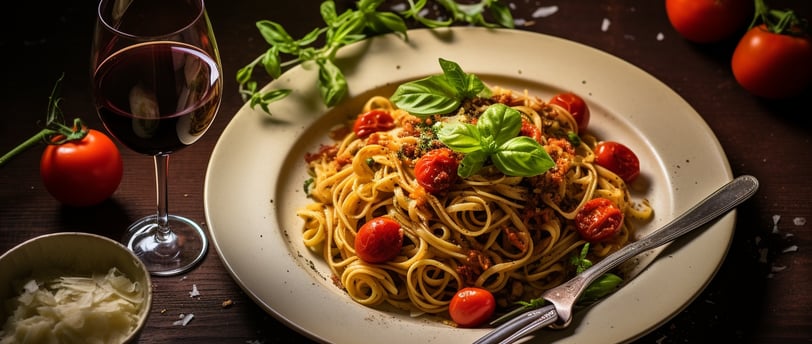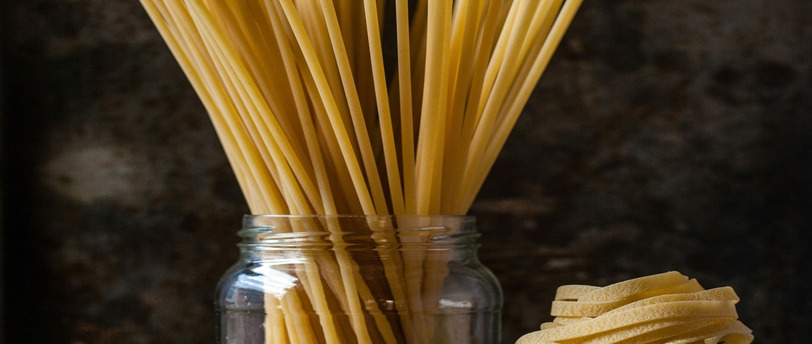The Art of Pasta Making: A Journey Through Italy's Regions
Embark on a culinary odyssey through Italy's regions, where each twist, turn, and fold in pasta-making tells a story of tradition, flavor, and the hands that have shaped it for centuries.

Italy is renowned for its culinary traditions, and one of the most iconic elements of Italian cuisine is pasta. From the north to the south, this versatile and delicious staple has various interpretations, reflecting the unique flavors and ingredients of each region. Join us on a journey through Italy's regions as we explore the art of pasta making.
Understanding the Basics of Pasta Making
Pasta making is an art that requires a deep understanding of ingredients, techniques, and traditions. The first essential element in creating perfect pasta is the ingredients themselves. Italians have long understood the importance of using high-quality ingredients to enhance the flavor and texture of their dishes.
The Importance of Ingredients in Pasta
From the northernmost tip of Italy to the sun-soaked islands of the south, each region takes pride in its local specialties. In the northern regions, such as Lombardy, rich and creamy pastas take center stage. The abundance of dairy farms in Lombardy provides an ample supply of fresh cream and cheese, resulting in velvety sauces that coat the pasta perfectly.
Heading south to Liguria, you'll find the influence of the sea reflected in pasta dishes. The Ligurian coast boasts an array of seafood, including anchovies, tuna, and shellfish. Traditional dishes like the famous pasta with pesto alla genovese showcase these flavors, creating a harmonious blend that evokes the coastal ambiance.
Traveling further south to Tuscany, you'll discover a region known for its rustic and hearty pasta dishes. Tuscan cuisine is deeply rooted in the use of simple, yet flavorful ingredients. A classic example is pici, a thick, hand-rolled pasta made with just flour and water. This humble pasta is often paired with rich ragù sauces, made with slow-cooked meats and aromatic herbs.
Continuing our culinary journey to the central region of Emilia-Romagna, we encounter the birthplace of iconic pasta shapes like tortellini and tagliatelle. Emilia-Romagna is renowned for its rich culinary heritage, and pasta plays a starring role in its gastronomic traditions. The region's fertile plains provide an abundance of fresh eggs and high-quality flour, resulting in pasta that is both delicate and robust in flavor.
As we venture to the southernmost part of Italy, we arrive in the vibrant region of Sicily. Here, the influence of Mediterranean flavors is evident in the pasta dishes. Sicilian cuisine is a fusion of various cultures, including Greek, Arab, and Spanish. The island's fertile soil produces an array of ingredients, such as sun-ripened tomatoes, fragrant herbs, and olives, which are incorporated into traditional pasta dishes like pasta alla Norma.
Exploring the diverse regions of Italy reveals the incredible variety of pasta and its deep connection to local ingredients and culinary traditions. Whether it's the creamy sauces of Lombardy, the seafood-infused dishes of Liguria, the rustic flavors of Tuscany, the delicate pasta of Emilia-Romagna, or the vibrant creations of Sicily, each region offers a unique and delicious experience for pasta enthusiasts.

Central Italy's Pasta Traditions
As we venture further into Italy's heartland, we encounter the robust and flavorful pasta traditions of Tuscany. The Tuscan countryside is known for its hearty meat dishes, and this influence extends to their pasta. Thick, meaty ragù sauces cling to pappardelle, a wide, ribbon-like pasta, creating a satisfying and comforting dish.
But Tuscany's pasta traditions go beyond just ragù. In the charming hilltop town of Siena, locals take pride in their traditional dish called pici. This hand-rolled pasta is thick and chewy, resembling fat spaghetti. It is typically served with a rich tomato sauce, flavored with garlic, chili, and a generous sprinkle of pecorino cheese. The simplicity of this dish allows the flavors of the ingredients to shine, making it a favorite among both locals and visitors.
Umbria, located just south of Tuscany, is known for its simple and rustic approach to pasta. With its picturesque landscapes and fertile soil, Umbria produces a bounty of fresh vegetables and wild mushrooms. It's no surprise that their pasta dishes feature these ingredients, allowing their natural flavors to shine through.
One of the most famous pasta dishes from Umbria is strangozzi al tartufo, a dish that celebrates the region's prized black truffles. Strangozzi, a type of long, square-shaped pasta, is cooked until al dente and then tossed in a luscious sauce made with butter, garlic, and grated truffle. The earthy aroma of the truffle permeates every bite, creating a truly indulgent experience.
Another beloved pasta dish from Umbria is umbricelli. These thick, hand-rolled noodles are made with just flour and water, giving them a rustic and chewy texture. They are often served with a simple sauce made from fresh tomatoes, garlic, and basil, allowing the natural sweetness of the tomatoes to shine through. This dish is a true representation of Umbria's commitment to simplicity and quality ingredients.
As we explore the pasta traditions of central Italy, it becomes clear that each region has its own unique approach and flavors. From the hearty ragù sauces of Tuscany to the earthy truffles of Umbria, every bite tells a story of tradition, passion, and the love for pasta that runs deep in the heart of Italy.
The Pasta of Southern Italy and the Islands
As we head south, we encounter the bold and vibrant flavors of Southern Italy and the islands. Calabria, a region known for its fiery cuisine, boasts spicy, tomato-based pasta dishes that pack a punch. Calabrian chilies, known as peperoncino, add a fiery kick to the sauces, creating a tantalizing experience for the taste buds.
Calabria, located in the southernmost part of the Italian peninsula, is a land of intense flavors and passionate cooking. The region's cuisine is heavily influenced by its geographical location, with the Mediterranean Sea to the west and the Ionian Sea to the east. This proximity to the coast means that seafood plays a significant role in Calabrian cuisine, and it is no different when it comes to their pasta dishes.
One popular Calabrian pasta dish is the "Spaghetti alla Calabrese." This dish features al dente spaghetti tossed in a rich tomato sauce infused with the heat of peperoncino. The sauce is made by simmering ripe tomatoes with garlic, olive oil, and a generous amount of peperoncino. The result is a vibrant and spicy sauce that clings to the pasta, creating a harmonious balance of flavors.
Another notable pasta dish from Calabria is the "Fileja con Nduja." Fileja is a traditional Calabrian pasta shape, similar to fusilli but with a twisted shape. Nduja, on the other hand, is a spicy spreadable salami made from pork and Calabrian chili peppers. In this dish, the fileja pasta is tossed with a sauce made from nduja, garlic, and olive oil. The nduja melts into the sauce, infusing it with its fiery flavor and creating a rich and indulgent pasta dish.
Further south, the island of Sicily reveals its unique gastronomic delights. With access to some of the freshest seafood in the Mediterranean, Sicilian pasta dishes are brimming with the flavors of the sea. From the iconic spaghetti alle vongole (spaghetti with clams) to the distinctive flavors of bottarga, a cured fish roe, Sicilian seafood pasta is a true culinary treasure.
Sicily, the largest island in the Mediterranean, is a melting pot of different cultures and influences, which is reflected in its cuisine. The island's strategic location in the middle of the Mediterranean Sea has made it a crossroads of civilizations throughout history. This rich cultural heritage is evident in the diverse flavors and ingredients found in Sicilian pasta dishes.
One beloved Sicilian pasta dish is the "Pasta con le Sarde." This dish combines fresh sardines, wild fennel, raisins, pine nuts, saffron, and breadcrumbs to create a symphony of flavors. The sardines are filleted and sautéed with garlic, olive oil, and wild fennel, which adds a unique aromatic note to the dish. The raisins and pine nuts provide a hint of sweetness and crunch, while the saffron adds a vibrant yellow color and a subtle earthy flavor. The pasta is then tossed in this flavorful sauce and topped with toasted breadcrumbs, adding a delightful texture to each bite.
Another Sicilian pasta specialty is the "Pasta alla Norma." This dish is named after the famous opera "Norma" by Vincenzo Bellini, who was born in Catania, Sicily. The pasta alla Norma is made with rigatoni or penne pasta, tossed in a sauce made from tomatoes, eggplant, garlic, basil, and ricotta salata. The eggplant is fried until golden and then combined with the tomato sauce, creating a rich and velvety texture. The dish is finished with a generous sprinkle of ricotta salata, a firm and salty cheese that adds a delightful contrast to the sweetness of the tomatoes and the creaminess of the eggplant sauce.

The Influence of Regional Ingredients on Pasta Dishes
Throughout our journey, we have seen how local ingredients shape the flavors of pasta dishes in each Italian region. The use of fresh, local produce is key in enhancing the taste and authenticity of these recipes.
The Role of Local Produce in Pasta Recipes
Whether it's the sun-ripened tomatoes of Campania or the vibrant greens of Puglia, regional produce plays a vital role in Italian pasta dishes. The fresher the ingredients, the more vibrant and flavorful the final dish will be. Italians take pride in sourcing their ingredients locally, ensuring that the essence of the region is captured in every bite.
A significant influence on pasta flavors comes from regional cheeses. From the creamy mozzarella in the south to the sharp pecorino in the center, Italian cheeses bring distinct flavors and textures to pasta dishes. The marriage of cheese and pasta is a match made in culinary heaven, creating a symphony of flavors that elevate the humble dish to new heights.
As you embark on your own culinary adventures, don't forget to explore the world of pasta. Master the art of making fresh pasta dough, experiment with regional recipes, and savor the flavors that embody the diverse regions of Italy. Buon appetito!
Savor Italian Pasta at Its Best
Embark on your own journey through Italy's regions and explore the art of pasta making. Discover the unique flavors and ingredients that define each region, from the rich, creamy pastas in Lombardy to the spicy, tomato-based dishes in Calabria. Immerse yourself in the traditions and techniques that have been passed down through generations, and savor the authentic tastes of Italy. Whether you're a passionate home cook or a curious traveler, the art of pasta making is a journey that will enhance your culinary repertoire. So, grab your apron, roll up your sleeves, and let the adventure begin! Buon viaggio!